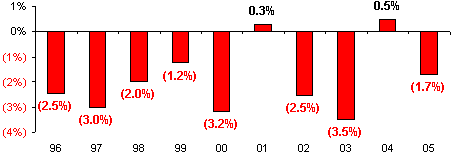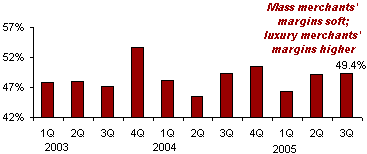IDEX Online Research: Retailers' Gross Margins Varied Widely in Q3
December 08, 05
For the third calendar quarter, aggregate gross margins were about flat with last year. However, this “average” reading masked what really happened in the industry. For luxury jewelers, gross margins rose. For mass market jewelers, gross margins fell. Gross margins (%) are defined as gross profit ($) as a percentage of sales. Gross profit is the amount left after the cost of goods sold, but before administrative costs, selling expenses, and other costs such as interest and depreciation.
Among high-end jewelers, both Tiffany and Mayor’s generated a higher gross margin. Tiffany cited sales mix changes and retail price increases as the major factors behind its higher gross margin.
Among the mass market jewelers, Finlay, Zale, and Sterling reported moderately lower gross margins versus the same quarter last year. Several factors had an impact on jewelers’ margins, including the following:
- Intense competition – With slow sales so far this year – year-to-date U.S. jewelry industry sales are up less than 2 percent through the end of September – jewelers have utilized the only tool they know how to use in an attempt to drive sales: they cut prices. When one jeweler cuts prices, the competition usually follows. The graph below illustrates how this has affected the jewelry industry. For eight of the past ten years (see graph), the retail jewelry industry has experienced declining retail prices. For the year-to-date 2005, retail prices of jewelry are down nearly 2 percent, despite higher materials costs and rising labor expense.
Jewelry Inflation Rate

Year
Source: Dept. of Commerce
- Higher commodities prices – Nearly every jeweler we talked with said that higher precious metals prices, and to a lesser extent higher diamond prices, had a detrimental impact on gross margins.
- Lack of price increases – Due to intense competition, jewelers have been unable to pass along materials cost increases. Again, the lack of price increases is reflected in the graph above. Because the jewelry industry is so fragmented, no single jeweler has pricing power in the same sense that Wal-Mart has pricing power. Thus, the continuing deflationary pricing trends are clearly the result of merchants who use price as their sole competitive differential, rather than developing innovative marketing and merchandising programs to create a clear competitive difference.
- Lack of sales leverage – Most jewelers believe that costs that are included in “costs of goods sold” are totally variable, since they relate to the product being sold. Generally accepted accounting principles call for certain “overhead” costs – buying, warehousing, and some other costs, for example – to be included in “cost of sales.” Thus, when sales are weak, these fixed or semi-fixed costs are inefficiently absorbed. This drives margins lower.
- Flattish LIFO – Some companies reported flat LIFO (Last In, First Out accounting method) charges in the third quarter; some reported lower life expense. The LIFO charge is determined by the inflation rate of the price of wholesale goods. Based on LIFO trends in the third quarter, product cost increases decelerated. It is important to note, in the context of deflationary retail prices, that jewelers’ merchandise costs continue to rise. For some reason – competition, perhaps – many jewelers have elected not to pass along these costs to their customers.
The graph below summarizes gross margin trends for jewelers in our sample.
Composite Gross Margin Trends
Publicly Held Retail Jewelers Percent of Sales
Source: Company reports